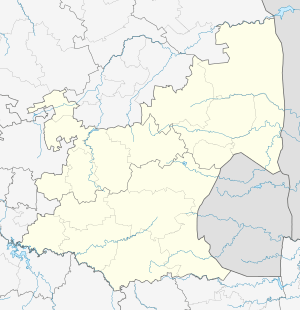Kamatsamo
| KaMatsamo Schoemansdal | |
|---|---|
 KaMatsamo  KaMatsamo KaMatsamo (South Africa)  KaMatsamo KaMatsamo (Africa) | |
| Coordinates: 25°42′11″S 31°30′22″E / 25.703°S 31.506°ECoordinates: 25°42′11″S 31°30′22″E / 25.703°S 31.506°E | |
| Country | South Africa |
| Province | Mpumalanga |
| District | Ehlanzeni |
| Municipality | Nkomazi |
| Area[1] | |
| • Total | 12.91 km2 (4.98 sq mi) |
| Population (2011)[1] | |
| • Total | 23,257 |
| • Density | 1,800/km2 (4,700/sq mi) |
| Racial makeup (2011)[1] | |
| • Black African | 99.3% |
| • Coloured | 0.2% |
| • Indian/Asian | 0.3% |
| • White | 0.1% |
| • Other | 0.1% |
| First languages (2011)[1] | |
| • Swazi | 94.8% |
| • Tsonga | 1.7% |
| • English | 1.1% |
| • Other | 2.3% |
| Time zone | UTC+2 (SAST) |
KaMatsamo, previously known as Schoemansdal, is a town in the province of Mpumalanga (eastern Transvaal) in South Africa. It is located 23 kilometres south of Malalane.
During the period when the policies of separate development were implemented under the apartheid regime, Schoemansdal was the capital of the bantustan named KaNgwane.
In November 2005 the South African government announced that the town's name had been changed to KaMatsamo. The new name is in honor of prince Matsamo Shongwe.Swazi Shongwe Matsamo Tribe. According to tradition, the Shongwe Matsamo were an independent tribe originated from a place in northern Zululand near the mouth of the Pongolo River (eLuphongolo). When Somhlolo was king of the Swazi people and Tikuni was chief of the Matsamo, they were driven out by the Zulu to Swaziland and settled at the Bulunga village in the district of Bremersdorp (today Manzini). Matsafeni, son of Tikuni, was a good soldier and King Mswati II moved his tribe to places where they had to defend the Swazi Kingdom. Between 1856 and 1865, the tribe under Chief Matsafeni were sent to defend the Kingdom against the Sotho tribes to the north of the Kingdom. A section of the Shongwe tribe remained in Bulunga, however. Up to the time of Magubha strong ties existed between the two sections. Today the two sections each have their own chief. Matsafeni built his head village on the eastern slopes of the hills to the west of the Mlumati River (the present Schoemansdal area) and called it Ka-Shongwe. Two other villages named Ka-NdlangamandIa and eSidungweni/Mashobeni were also built. After the death of Mswati II, Matsafeni Shongwe joined forces with Matsafeni Mdluli, another Swazi general, in a war with the Sotho people, who were driven northward to Mhuluhulu near Hoedspruit. They looted the cattle of the Sotho and incorporated young children into the Shongwe tribe. Matsafeni Shongwe died after the Sotho war (1850-1868) of small-pox and was buried near the present Shongwe Mission where his grave can still be seen.
Smallpox wiped out the entire Ka-NdlangamandIa village and the Mashobeni village moved to Swaziland. Matsafeni was succeeded by his son Matsamo, who was also a warrior who had served in wars over cattle and land against the Sotho, the Shangaans and the Bajobi of Mozambique. An historical incident from this era explains the origin of one of the tribes of the eastern Nkomazi region. After one of the wars, Matsamo fell ill and had to be left behind by his soldiers. He was cared for by the people of Mahlalela in the Mbozini region and was escorted back to Swaziland by Mahlalela. To express his gratitude, king Mswati II gave aid to Mahlalela and made him chief of what is today the MIambo tribe. Matsamo had 30 wives and established sixteen villages where his sons lived, in the areas of Mzinti, Schulzendal, Middelplaas, Schoemansdal, Jeppe's Reef and in Swaziland. Matsamo would probably have been succeeded by his son Lugebhuda, but he but he predeceased his father in 1912. Lugebhuda's son, Magubha/Sidlamafa, was appointed by Matsamo as his successor shortly before his death in 1925. Matsamo is remembered as a good chief who was loved by everybody. He was tolerant and willing to give land to people not of his tribe, including a number of white people, like Kirk, Schoeman and Gilliland (?) who obtained farms in the Matsamo tribal area. Matsamo's son Njiyeza acted as regent until Magubha came of age in 1929. As eldest son of Matsamo's first wife, Lozindaba, Njiyeza was the spiritual leader of the family. He drowned in the Ngugwane in 1937. Magubha/Sidlamafa was the son of Lugebhuda's wife Mangeti, who was a granddaughter of Mswati II. He was born ca. 1909 and lived at the eMbanweni village on Schoemansdal. He reigned for eleven years and was buried next to Matsamo. Magubha is remembered as a stern man, but also as a chief who upheld the old traditions and retained good relationships with the people of Swaziland. After Magubha/Sidlamafa's death, Sisini, son of his father's first wife Silele, acted as regent from 1941 to his death in 1945. Sithulele, half brother of Lugebhuda and full brother of the regent Njiyeza, succeeded Sisini and acted from 1945 to 1955. From 1955 to 1962, Sigweje, another son of Matsamo, acted as regent. After three successive regents, Tinhlohla/Amos, son of Sidlamafa/Magubha's second wife Totoyi, became full chief and reigned till 1981. It was during his time, in 1970, that the first secondary school of the tribal area, the Shongewe Secondary School, was built. After Tinhlohla's death, his half-sister Mdzili/Grace, who is remembered as a very kind person, acted from 1981-1982. Mahusha, another son of Magubha took over from Mdzili and acted until his death in 1992. In 1993 Obed/Sikhumbuzo, son of Tinhlohia was instated and the new tribal offices were officially opened.
References
- 1 2 3 4 "Main Place KaMatsamo". Census 2011.
.svg.png)